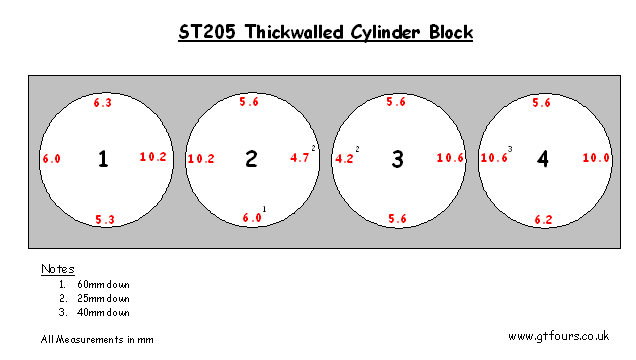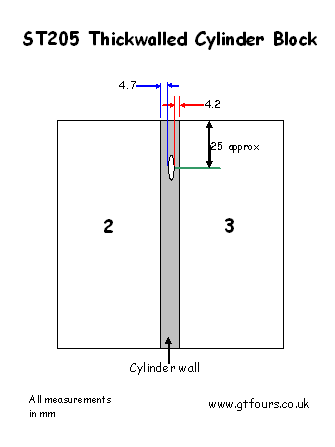205 Thick Walled Cylinder Block
What's this I've heard that some 205 Cylinder Blocks are Thick and some are thin?
It would seem that some Blocks are thicker, or exhibit less casting defects than others. With less casting defects the block "appears" thicker and is thus deemed to be a good 'un!
The particular area of concern to identify the difference between a thick and thin Block is small and can EASILY be missed.
Any more info on the Block?
Toyota changed the part number of the Block, (the reason for which is unknown), but speculation has it that this was to address "issues" - I'm sceptical...
The 2 Blocks supplied by Toyota are:
Part No. 11401-79675 – manufactured 94/02 > 98/01
Part No. 11401-79676 – manufactured 98/01 > 99/08
All Blocks bought from Toyota nowadays are supplied under the latter Part No. (A new Block is ~£700+VAT). A new Block does not guarantee a thick one...
What does the Block look like?
It looks something like this...
How can I measure the thickness?
The only method I know of that appears to be accurate is with an ultrasonic measuring gizmo. There are Companies/geeks that specialise in this field of measurement, and probably the best way to find one would be looking through a local Internet search engine e.g. (in the UK) www.thomsonlocal.com and www.yell.com
For a small fee, a geeky person can be employed for a max of 1 hour, (all that is required), to examine your cylinder block with an ultrasonic machine, paying particular and meticulous care 25mm down between cylinders 2 and 3 of your block. If you are unlucky this will cost you £50 to have the Block measured.
You may want to ask your friendly examiner to bring a curved or the smallest probe they have to avoid errors/inaccuracies caused by the probe not fitting flush to the cylinder walls...
Measurement with a vernier, micrometer or whatever other fancy mechanical instrument isn't possible due to very limited access.
What is the difference between a Thick and a Thin Block?
Commonly the thinnest place appears to be between the cylinder walls on No.2 and No.3 cylinders. The dimensions are shown below, (I took these from my block);
 |
| Dimensions of Block and particular areas of interest Note that the measurements were from an un-bored JDM WRC block that had covered ~60k miles Only the minimum measurements shown |
A thick Block is "considered" to have all parts of the cylinders >3.8mm.
A thin Block is considered to have an area between cylinders 2 and 3 <3.8mm. The difference seems to be quite obvious between a thick and thin Block as the cylinder wall can be extremely thin, maybe down to 2.3mm!! Note that all cylinders should be measured, but particular care is to be given to between cylinder 2 and 3 and the rear of cylinder 4.
 |
| From measurements it would seem that the wall between cylinder 2 and 3 is not entirely solid
Approx 25mm down there is a small "break" in the cylinder |
Why should I be bothered if I have a Thick or Thin Block?
It seems quite common for a block to split if the power is increased significantly beyond the original designed limit. The increased forces and heat inside the cylinder seem to help the block crack. As the heat and stressed climb it would also appear that the cooling of the cylinders becomes ever more critical, and insufficient cooling may also help the block to crack.
Note that standard hp cars have been known to split blocks, so planning a high hp engine, some attention needs to be given to the thickness of the Block.
By far the most common point for the block to crack is either in cylinder 2 or cylinder 3, as shown above.
Will fitting cylinder liners help?
It doesn't seem that it will. Maybe there is special technique to fitting liners and having them last at high output powers. Below are some pictures of a linered 205 Block. The car was running ~500hp 400tq.
Is there anything I can do to help prevent cracking?
A tough question! No-one seems to have found the definitive answer, yet! Possible theories and thoughts could be:
Note that often higher output engines are running higher rpm limits. This will affect the operation of the stock cooling system, both in terms of the operation of the water pump and the flow through and across/through the block...
If you have any more information or pictures then please e-mail me -
Thanks to Gary Stewart for the cracked block picture